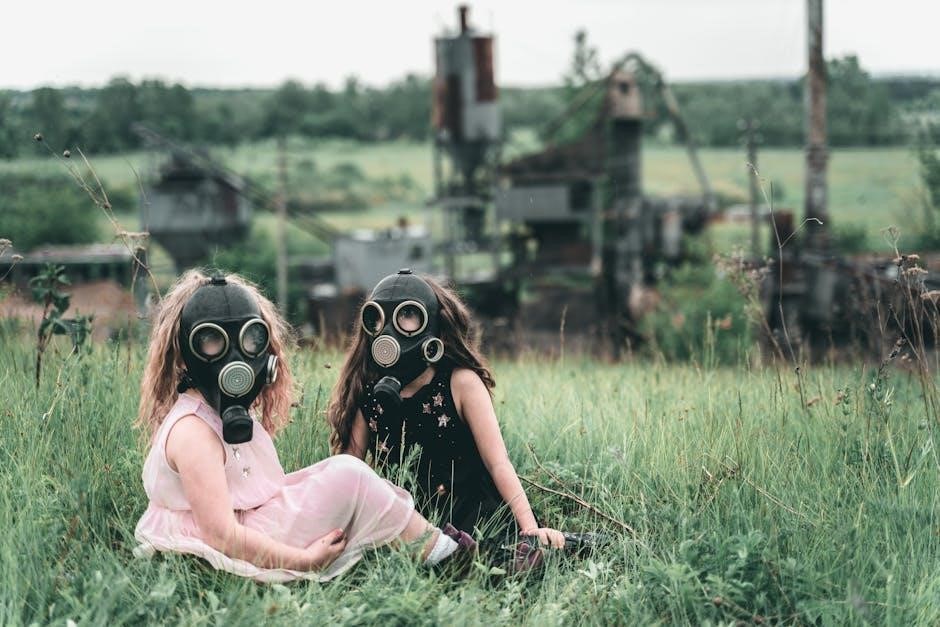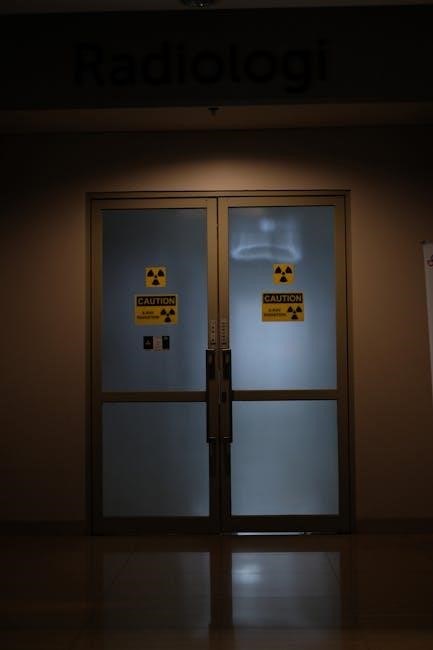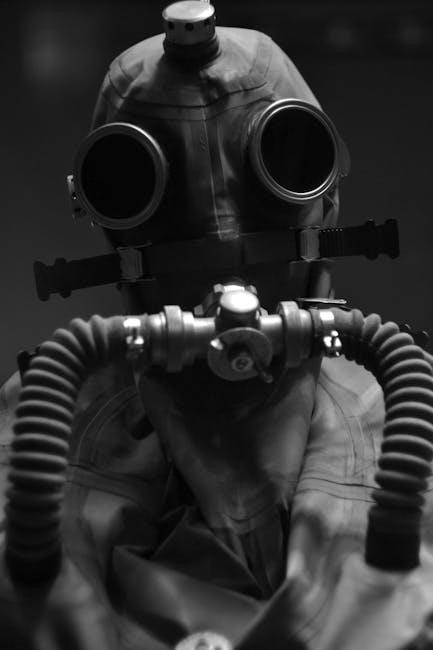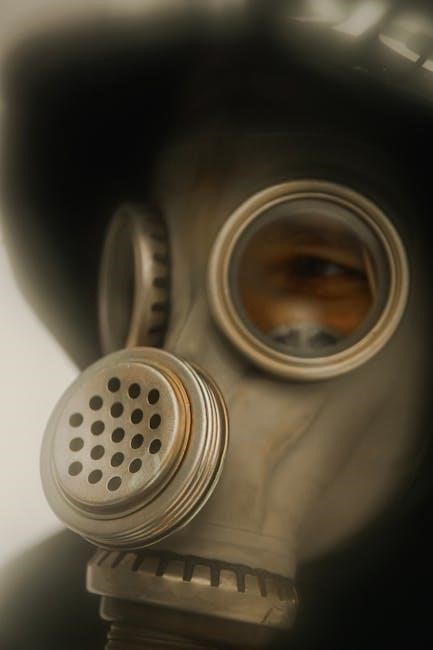Radiation safety is crucial for protecting people and the environment from harmful effects of ionizing radiation. It involves understanding risks, using protective measures like time, distance, and shielding, and adhering to regulations to minimize exposure and ensure safety in various settings.
1.1 Definition and Importance of Radiation Safety
Radiation safety refers to practices and measures designed to protect individuals and the environment from the harmful effects of ionizing radiation. It is essential for minimizing health risks, ensuring legal compliance, and promoting public confidence in industries using radiation. Key principles include the ALARA principle, which aims to keep exposure as low as reasonably achievable. Protective measures like time, distance, and shielding are fundamental. Radiation safety is critical in medical, industrial, and research settings to prevent acute and long-term health effects, such as cancer and genetic damage, ensuring safe handling and use of radioactive materials.
1.2 Overview of Ionizing and Non-Ionizing Radiation
Radiation is categorized into ionizing and non-ionizing based on its energy and interaction with matter. Ionizing radiation, such as X-rays, gamma rays, and alpha particles, has enough energy to ionize atoms, potentially causing DNA damage and health risks like cancer. Non-ionizing radiation, including radio waves and microwaves, lacks ionizing power but can still cause tissue heating. Understanding these differences is vital for assessing risks and implementing appropriate safety measures. Ionizing radiation requires strict controls due to its harmful effects, while non-ionizing radiation, though less dangerous, still needs management to prevent occupational hazards.
Key Principles of Radiation Safety
Radiation safety relies on minimizing exposure through time, distance, and shielding. The ALARA principle ensures doses are kept as low as reasonably achievable, prioritizing worker and public protection.
2.1 The ALARA Principle (As Low As Reasonably Achievable)
The ALARA principle emphasizes minimizing radiation exposure to levels as low as reasonably achievable, ensuring doses are kept below regulatory limits while maintaining operational efficiency. This principle encourages the use of time, distance, and shielding to reduce exposure, balancing safety with practicality. By avoiding unnecessary exposure, ALARA helps protect workers and the public from potential health risks associated with ionizing radiation, aligning with regulatory standards and promoting a culture of safety in radiation-related activities.
2.2 Time, Distance, and Shielding as Protective Measures
Time, distance, and shielding are fundamental protective measures in radiation safety. Minimizing exposure time reduces dose accumulation, while increasing distance from the source significantly lowers radiation intensity. Shielding involves using materials like lead or concrete to block or absorb radiation, effectively reducing exposure. These practices, combined with proper training, help ensure safety in environments where ionizing radiation is present, aligning with regulatory guidelines and the ALARA principle to minimize risks to workers and the public.

Types of Radiation and Their Hazards
Radiation includes ionizing and non-ionizing types, with ionizing radiation posing greater health risks due to its ability to damage cellular DNA, potentially causing cancer or genetic harm.
3.1 Alpha, Beta, Gamma, and X-Ray Radiation
Alpha, beta, gamma, and X-ray radiation are types of ionizing radiation. Alpha particles are heavy, stopped by skin, but dangerous if ingested. Beta particles penetrate deeper, requiring thin shielding. Gamma and X-rays are highly penetrating, needing dense materials like lead to block them. Understanding their characteristics is key to managing risks and implementing proper safety measures to protect against exposure and potential health hazards.
3.2 Health Effects of Ionizing Radiation Exposure
Ionizing radiation exposure can cause severe health effects by damaging DNA and living tissues. Acute exposure may lead to radiation sickness, including nausea, fatigue, and organ failure. Long-term effects include increased cancer risk, genetic mutations, and potential harm to unborn children. The severity depends on dose, duration, and type of radiation. Understanding these risks is crucial for implementing safety measures and protecting individuals from the harmful consequences of radiation exposure in various settings.
Radiation Safety Measures in the Workplace
Implementing OSHA standards, the ALARA principle, and using protective measures like time, distance, and shielding are essential to minimize radiation exposure and ensure workplace safety.
4.1 Personal Protective Equipment (PPE) for Radiation Protection
Personal Protective Equipment (PPE) is essential for minimizing radiation exposure. Common PPE includes lead aprons, thyroid collars, gloves, and respirators. These items block or reduce radiation penetration, protecting vital organs. Proper fitting and maintenance ensure effectiveness. PPE selection depends on radiation type and intensity. Regular training on PPE use is critical for workplace safety. Employers must provide appropriate gear, and workers must wear it correctly. PPE, combined with time, distance, and shielding, aligns with the ALARA principle to keep doses as low as reasonably achievable.
4.2 Proper Use of Shields and Barriers
Shields and barriers are critical for blocking ionizing radiation. Made from materials like lead or concrete, they absorb or deflect radiation, reducing exposure. Proper placement and thickness ensure effectiveness. Mobile shields are useful in medical settings, while fixed barriers are common in industrial areas. Lead glass windows protect eyes during procedures. Regular inspection of shields is essential to maintain integrity. Improper use can lead to exposure risks. Training on shield placement and maintenance is vital for workplace safety. Shields, when used correctly, significantly reduce radiation doses, aligning with safety protocols and regulatory standards.
4.3 Minimizing Exposure Time and Maximizing Distance

Minimizing exposure time and maximizing distance are key radiation safety practices. Reducing the duration of exposure lowers the radiation dose received. Increasing distance from the source leverages the inverse square law, where radiation intensity decreases with distance. Planning tasks to limit time near radiation sources and using remote tools can help. This approach aligns with the ALARA principle, ensuring doses are as low as reasonably achievable. Proper training and awareness of these practices are essential for workplace safety, reducing risks without compromising operational efficiency or effectiveness.

Regulatory Framework and Standards
Regulatory frameworks ensure radiation safety through enforceable standards, protecting workers and the environment. Federal agencies and international bodies like OSHA and IAEA establish guidelines to mitigate risks effectively.
5.1 OSHA Standards for Ionizing Radiation Exposure
OSHA sets standards to protect workers from ionizing radiation hazards. These standards include exposure limits, monitoring requirements, and training mandates. Employers must ensure radiation levels are controlled, and workers are trained on safety practices. Personal protective equipment and engineering controls are also required to minimize exposure. OSHA standards apply across industries, including general industry, maritime, and construction. Compliance with these standards is essential to safeguard worker health and prevent radiation-related illnesses. Regular monitoring and record-keeping are critical to ensure adherence to OSHA’s radiation safety guidelines.
5.2 International Atomic Energy Agency (IAEA) Guidelines
The IAEA provides global guidelines to protect people and the environment from ionizing radiation. These guidelines emphasize safe practices in medical, industrial, and nuclear applications. They include recommendations on radiation monitoring, waste management, and emergency preparedness. The IAEA also promotes training and public awareness to enhance radiation safety worldwide. By adhering to these guidelines, countries can ensure compliance with international safety standards and mitigate radiation risks effectively. The IAEA’s framework supports continuous improvement in radiation protection, fostering a culture of safety across all sectors.
5.3 Role of Federal Agencies in Radiation Protection
Federal agencies play a critical role in enforcing radiation safety standards and protecting workers and the public. OSHA sets exposure limits for ionizing radiation in workplaces, while other agencies like the NRC regulate nuclear materials. These bodies ensure compliance with safety protocols, provide training, and conduct inspections to prevent radiation hazards. Their guidelines help industries adopt best practices, minimizing risks and ensuring safe handling of radioactive materials. Federal oversight is essential for maintaining a robust radiation protection framework across all sectors.

Radiation Safety in Medical and Industrial Settings
Radiation safety is vital in medical and industrial settings to protect workers and patients. Medical imaging and therapy use ionizing radiation, requiring precise dosages and protective measures. Industrial applications, like sterilization and testing, also demand strict safety protocols to prevent exposure and ensure safe handling of radioactive materials.
6.1 Radiation Safety in Medical Imaging and Therapy
Radiation safety in medical imaging and therapy is critical to minimize exposure while ensuring effective treatment. Techniques like CT scans and radiation therapy require precise dosages to balance diagnostic benefits and patient safety. Protective measures include using lead aprons, thyroid collars, and shielding to reduce exposure. The ALARA principle guides practices to keep doses as low as reasonably achievable. Regular monitoring and training for healthcare workers are essential to maintain safety standards and prevent overexposure. Proper handling of radioactive materials and equipment calibration further ensure safe and effective medical procedures.
6.2 Industrial Applications of Ionizing Radiation
Ionizing radiation is widely used in industrial applications for quality control, sterilization, and defect detection. Techniques like X-ray inspection and gamma-ray radiography ensure material integrity without physical damage. Radiation-based gauges measure thickness and density in manufacturing processes. Sterilization of medical devices and food irradiation are key applications, ensuring safety and extending shelf life. Industrial radiation safety relies on shielding, proper equipment design, and adherence to the ALARA principle. Regular monitoring and training for workers are essential to minimize exposure risks. These practices balance industrial efficiency with radiation protection, ensuring compliance with safety standards and regulations. Proper handling and storage of radioactive sources are critical to maintaining a safe working environment.

Radiation Detection and Monitoring
Radiation detection and monitoring are essential for ensuring safety and compliance with standards. Handheld multi-purpose radiation detectors and regular monitoring systems help identify and measure radiation levels accurately.
7.1 Handheld Multi-Purpose Radiation Detectors
Handheld multi-purpose radiation detectors are essential tools for detecting and measuring ionizing radiation in various environments. These portable devices are designed to identify alpha, beta, gamma, and X-ray radiation, ensuring accurate and reliable readings. They are widely used in industrial, medical, and emergency response settings to monitor radiation levels and protect workers from potential hazards. Advanced models offer real-time data, alarms for exceeding safe thresholds, and durability for use in challenging conditions. Their versatility and ease of use make them indispensable for maintaining radiation safety and complying with regulatory standards in diverse applications.
7.2 Importance of Regular Radiation Monitoring
Regular radiation monitoring is vital for ensuring a safe environment and preventing overexposure to ionizing radiation. It helps in early detection of potential hazards, allowing timely corrective actions to minimize risks. Continuous monitoring ensures compliance with safety standards and regulations, protecting both workers and the public. By tracking radiation levels, employers can assess workplace safety, implement controls, and maintain a record of exposure for future reference. This practice is essential in medical, industrial, and research settings where radiation exposure is a common risk, ensuring the well-being of individuals and the environment.
Emergency Response and Incident Management
Effective emergency response and incident management are critical to minimizing risks during radiation-related incidents. Preparedness, swift action, and clear communication ensure safety and reduce potential hazards.
8.1 Procedures for Radiation Spills or Leaks
In case of a radiation spill or leak, immediate action is essential to minimize exposure and contamination. Evacuate the area, notify personnel, and secure the site to prevent unauthorized access. Trained individuals should assess the situation, wearing appropriate PPE, and contain the spill using absorbent materials or barriers. Decontamination procedures must follow established protocols to ensure safety. Documenting the incident and conducting a thorough cleanup is crucial. Regular training and drills ensure preparedness for such emergencies, emphasizing the importance of swift and coordinated responses to protect health and the environment.
8.2 Decontamination and Post-Incident Safety Measures
After a radiation spill or leak, decontamination is critical to restore safety. Trained personnel should assess the area, wearing PPE, and use specialized cleaning solutions to remove radioactive material. Surfaces must be thoroughly scrubbed and rinsed, with waste disposed of according to regulations. Post-incident, monitor radiation levels to ensure safety. Document all steps for future reference and conduct a thorough investigation to prevent recurrence. Training and drills are essential to prepare for such events, ensuring effective and timely responses to protect health and the environment from radiation exposure risks.

Radiation Waste Management
Radiation waste management involves safe handling, storage, and disposal of radioactive materials to minimize environmental impact and ensure compliance with safety guidelines and regulations.
9.1 Safe Handling and Storage of Radioactive Materials
Safe handling and storage of radioactive materials are critical to minimizing exposure risks. Proper techniques, such as using tongs or gloves, and storing materials in labeled, secure areas, are essential. Always follow guidelines for packaging, transportation, and segregation to prevent contamination. Regular training and consultation with radiation safety experts ensure compliance with regulations and best practices, protecting both people and the environment from potential hazards.
9.2 Disposal of Radioactive Waste
Disposal of radioactive waste requires strict adherence to regulations to prevent environmental contamination and health risks. Waste must be segregated by type and activity level, stored in secure, labeled containers, and disposed of in approved facilities. Incineration, burial, and specialized storage are common methods, ensuring minimal leakage. Proper documentation and compliance with guidelines from agencies like the IAEA and OSHA are essential. Regular monitoring and training for handlers are critical to maintain safety and environmental protection, ensuring radioactive waste is managed responsibly and sustainably.

Public Awareness and Education
Public awareness and education are vital for understanding radiation risks and benefits, fostering community engagement, and promoting safety practices to protect people and the environment effectively.
10.1 Understanding Radiation Risks and Benefits
Understanding radiation risks and benefits is essential for informed decision-making. Ionizing radiation, such as X-rays and gamma rays, can pose health risks, including cancer, but also offers medical benefits like cancer treatment and imaging. Non-ionizing radiation, like radio waves, typically has lower risks. The ALARA principle emphasizes minimizing exposure to unnecessary radiation. Public awareness campaigns highlight both the hazards and the advantages of radiation, ensuring people grasp its role in medicine, industry, and environmental protection. Balancing these aspects fosters a safer and more informed approach to radiation use and protection.
10.2 Community Engagement in Radiation Safety
Community engagement is vital for fostering radiation safety awareness. Public outreach programs, workshops, and educational materials help residents understand radiation risks and benefits. Collaborating with local leaders ensures tailored messaging, addressing specific concerns. Engaging communities in safety practices, such as emergency preparedness, builds trust and promotes collective responsibility. Open dialogue and transparent communication are key to empowering individuals and communities to make informed decisions about radiation safety. This proactive approach ensures that everyone contributes to a safer environment, aligning with global efforts to protect people and the planet from radiation hazards.

Training and Certification Programs
Structured programs ensure workers understand radiation risks and safety protocols, complying with OSHA and IAEA standards to enhance competence and safety in handling ionizing radiation.
11.1 Radiation Safety Training for Workers
Radiation safety training is essential for workers to understand risks and protective measures. It covers principles like ALARA, time, distance, and shielding, ensuring safe handling of ionizing radiation. Training includes recognizing radiation sources, using PPE, and emergency procedures. Regular updates keep workers informed on new technologies and regulations, minimizing exposure risks. This structured approach ensures compliance with OSHA and IAEA standards, promoting a culture of safety in medical and industrial settings. Effective training empowers workers to protect themselves and others, adhering to best practices for radiation safety.
11.2 Certification Requirements for Radiation Safety Officers
Certification for Radiation Safety Officers (RSOs) is essential to ensure expertise in radiation protection. RSOs must meet specific requirements, including training in radiation principles, safety measures, and regulatory compliance. Certification often involves passing exams and staying updated on standards from OSHA, IAEA, and other agencies. RSOs must demonstrate knowledge of ionizing radiation types, exposure limits, and emergency response protocols. Continuous learning and recertification are critical to maintain proficiency and adapt to new technologies and regulations, ensuring safe practices in radiation handling and workplace safety.
Future Trends in Radiation Safety
Future trends include advancements in radiation detection technology and sustainable practices to minimize exposure risks, ensuring safer environments and compliance with evolving regulatory standards globally.
12.1 Advances in Radiation Detection Technology
Recent advancements in radiation detection technology include the development of handheld multi-purpose radiation detectors capable of identifying all types of ionizing radiation. These devices enhance safety by providing rapid and accurate detection, enabling timely responses to potential threats. Improved sensors and software algorithms increase sensitivity and reduce false alarms, making them indispensable in industrial and medical settings. Such innovations not only boost workplace safety but also aid in environmental monitoring and public health protection, ensuring better preparedness for radiological incidents and minimizing risks effectively.
12.2 Emerging Challenges in Radiation Protection
Emerging challenges in radiation protection include managing radioactive waste, ensuring strict regulations, and addressing public concerns about exposure risks. The harmful effects of radioactive waste necessitate advanced disposal methods and international cooperation. Regulatory frameworks must evolve to address new technologies and threats. Additionally, the need for continuous learning and updated safety practices remains critical. Organizations like the IAEA play a vital role in setting global standards and providing guidance. These challenges require innovative solutions, collaboration, and public awareness to ensure effective radiation protection and minimize risks to both humans and the environment.

Conclusion
Radiation safety is essential for protecting health and the environment. Key practices include minimizing exposure, using shielding, and adhering to ALARA principles. Continuous learning and updated guidelines ensure ongoing protection and safety in all settings.
13.1 Summary of Key Radiation Safety Practices
Effective radiation safety practices include minimizing exposure time, maximizing distance from sources, and using shielding. Adhering to the ALARA principle ensures doses remain as low as reasonably achievable. Proper use of PPE, regular monitoring, and safe storage of radioactive materials are essential. Training and certification programs for workers and radiation safety officers are critical. Emergency preparedness, including spill procedures and decontamination, must be in place. Compliance with OSHA standards and IAEA guidelines ensures a structured approach to radiation protection. Continuous learning and community engagement further enhance safety practices, promoting a culture of awareness and responsibility.
13.2 The Importance of Continuous Learning in Radiation Safety
Continuous learning is vital in radiation safety due to evolving technologies and regulatory updates. Staying informed about new practices, tools, and guidelines ensures adherence to safety standards. Training programs and certifications help workers and officers remain competent. Engaging with updated resources, like the “radiation safety questions and answers pdf,” enhances understanding of risks and mitigation strategies. Learning fosters adaptability to emerging challenges, such as new radiation sources or incidents. A culture of lifelong learning ensures individuals and organizations remain prepared to handle radiation-related tasks safely and responsibly, protecting both people and the environment from potential hazards.
